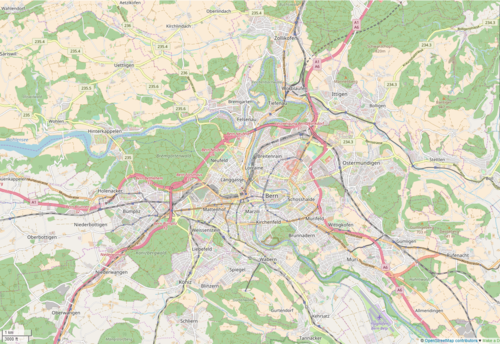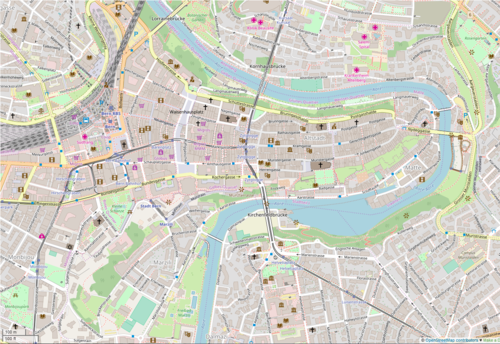
Lake Zurich is a lake in Switzerland, extending southeast of the city of Zürich. Depending on the context, Lake Zurich or Zürichsee can be used to describe the lake as a whole, or just that part of the lake downstream of the Hurden peninsula and Seedamm causeway. In the latter case, the upstream part of the lake is called Obersee, whilst the lower part is sometimes also referred to as the Lower Lake, respectively.

The Nydeggbrücke is a bridge in Bern, Switzerland which connects the eastern part of the old city to the new part. It crosses over the Aare and is located very close to the Bärengraben. It was built in parallel to the Untertorbrücke in 1840, which until then had been the only bridge crossing the Aare. The Nydeggbrücke is in total 190 meters long and took three years to build. It is a Swiss heritage site of national significance.

The Untertorbrücke is a stone arch bridge that spans the Aare at the easternmost point of the Enge peninsula in the city of Bern, Switzerland, connecting the Mattequartier in the Old City to the Schosshalde neighbourhood. Built in its current form in 1461–89, it is the oldest of Bern's Aare bridges, and was the city's only bridge up until the middle of the 19th century. It is a Swiss heritage site of national significance.

The Old City is the medieval city center of Bern, Switzerland. Built on a narrow hill bordered on three sides by the river Aare, its compact layout has remained essentially unchanged since its construction during the twelfth to the fifteenth century. Despite a major fire in 1405, after which much of the city was rebuilt in sandstone, and substantial construction efforts in the eighteenth century, Bern's old city has retained its medieval character.
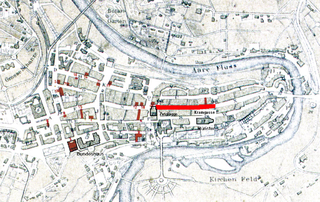
The Kramgasse is one of the principal streets in the Old City of Bern, the medieval city centre of Bern, Switzerland. It was the center of urban life in Bern until the 19th century. Today, it is a popular shopping street. Its length, slight curve and long line of Baroque façades combine to produce Bern's most impressive streetscape.

The Gerechtigkeitsgasse is one of the principal streets in the Old City of Bern, the medieval city center of Bern, Switzerland. Together with its extension, the Kramgasse, it is the heart of the inner city. Hans Gieng's most famous fountain figure, the statue of Lady Justice on the Gerechtigkeitsbrunnen, commands the view of the street's gentle slopes and curves.

The Gerechtigkeitsbrunnen is a 16th-century fountain in the Gerechtigkeitsgasse in the Old City of Bern, Switzerland. It is the only Bernese fountain to retain all original design elements, and is listed as a cultural heritage of national significance.

The Junkerngasse is a street in the Old City of Bern, the medieval city center of Bern, Switzerland. It connects the tip of the Aar peninsula to the Münster.

The Felsenau power plant is a hydroelectric power plant located on the river Aar in Bern, Switzerland. It was built in 1909 by the city's utility company, Energie Wasser Bern. After a 1989 modernisation, the turbine hall is now used as a museum. The plant's current power output is 11.5 megawatts.
Bümpliz-Oberbottigen is a Stadtteil (district) of the city of Bern, Switzerland. It is situated to the west of the city center and consists of the Quartiere (quarters) Bümpliz, Oberbottigen, Stöckacker, Bethlehem and Brünnen.

The Herrengasse is one of the streets in the Old City of Bern, the medieval city center of Bern, Switzerland. It was the southernmost street of the old Zähringerstadt of Bern and ended at the first city wall. Three buildings on the Herrengasse are listed on the Swiss inventory of heritage site of national significance and it is part of the UNESCO Cultural World Heritage Site that encompasses the Old City.

Gottstat Monastery is a former Premonstratensian monastery in the municipality of Orpund in the Canton of Bern, Switzerland.
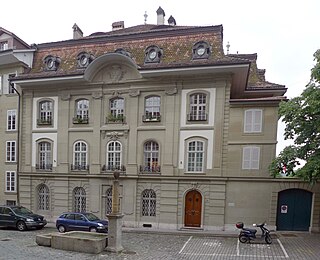
The von Wattenwyl house on Herrengasse 23 is a historic building in Bern, Switzerland, named after the von Wattenwyl family who owned it for over 200 years.
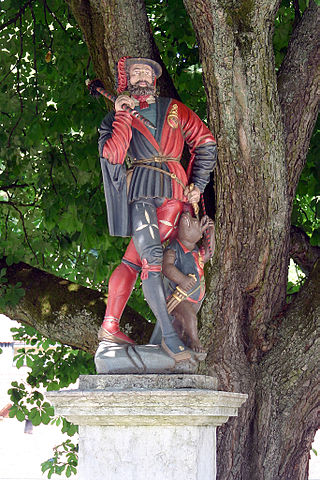
The Läuferbrunnen is a fountain on Läuferplatz in the Old City of Bern, Switzerland. It is a Swiss Cultural Property of National Significance and is part of the UNESCO World Heritage Site of the Old City of Bern.
The Zähringerbrunnen is a fountain on Kramgasse in the Old City of Bern, Switzerland. It is a Swiss Cultural Property of National Significance and is part of the UNESCO World Heritage Site of the Old City of Bern.
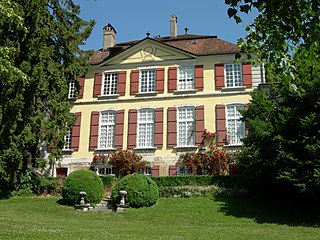
Blumenstein Castle is an estate house in the municipality of Solothurn of the Canton of Solothurn in Switzerland. It is a Swiss heritage site of national significance. In 1952 it became the home of the Historical Museum of Solothurn.

The Lorraine railway viaduct, or Lorraineviadukt, is a railway viaduct in the Swiss city of Bern. It carries the Olten–Bern railway across the River Aare immediately to the north of Bern railway station. The Lorraine road bridge is adjacent.
The following is a timeline of the history of the municipality of Bern, Switzerland.
Ellen Judith Beer was a Swiss art historian. She focused on Medieval art.

John Burnaby (1701–1774) was a British diplomat. He was Resident minister to the Swiss cantons.
The data in this list are taken from Furrer, p. 154–164, unless otherwise noted.

